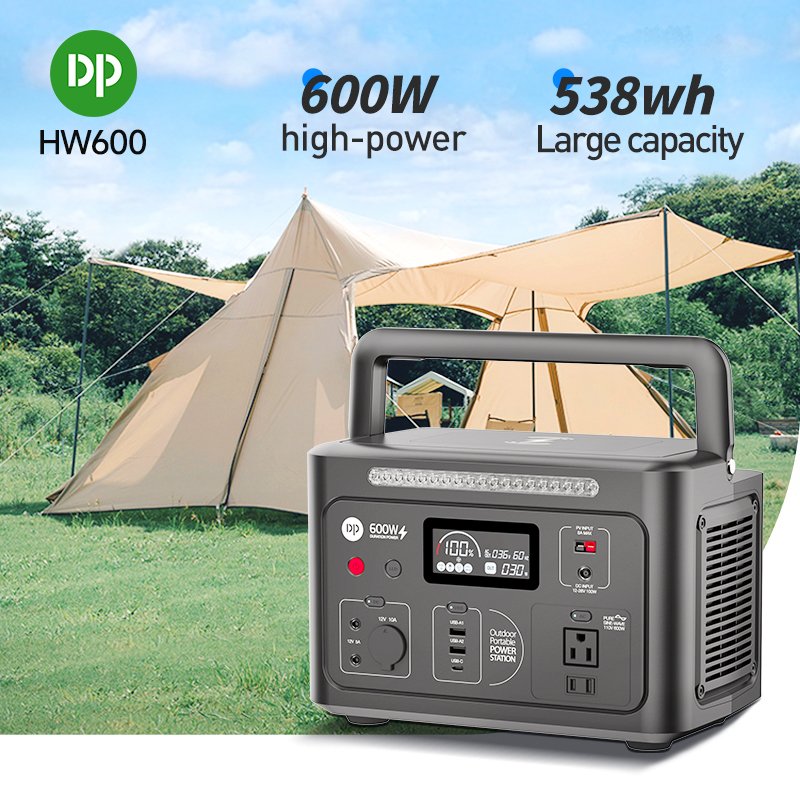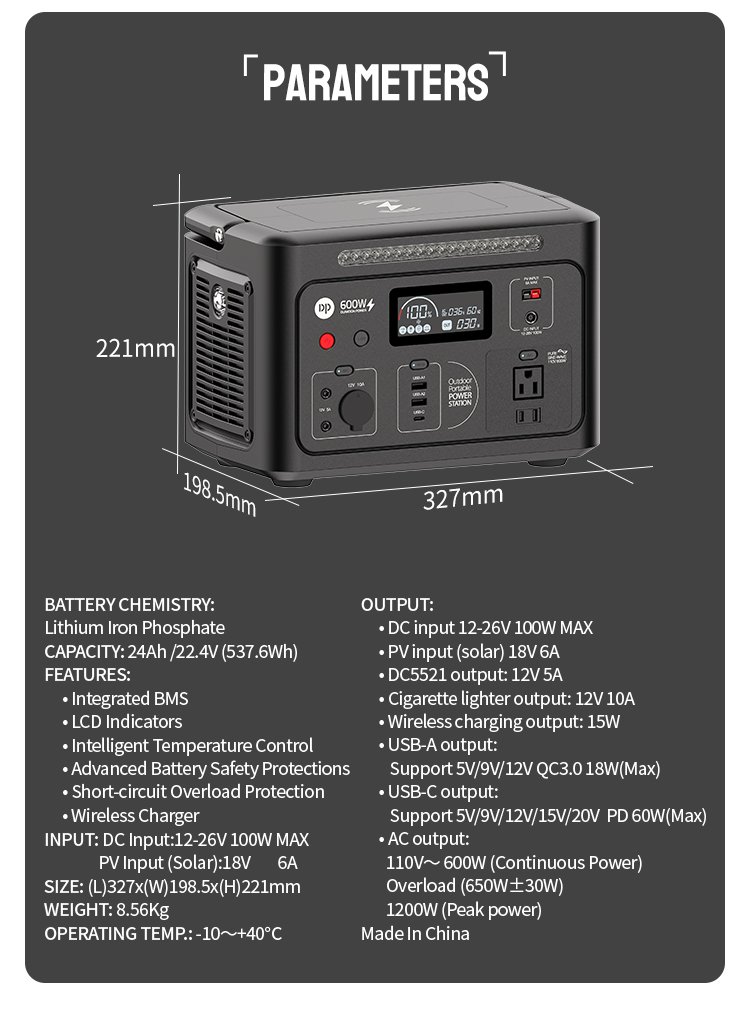Ever stared at a spec sheet for a portable power station and felt like you’re reading alien hieroglyphics? You’re not alone. Terms like battery capacity, rated voltage, and peak power sound like jargon from a sci-fi movie—but they’re actually the GPS coordinating your off-grid adventures. Think of these specs as your power station’s DNA—they define what it can (and can’t) do. Ready to crack the code? Let’s dive in.
1. Watt-Hours (Wh): Your Power Station’s Fuel Tank
Picture watt-hours as your energy savings account. It measures total storable juice. A 1000Wh unit? That’s roughly ten smartphone charges or four hours running a mini-fridge. But here’s the kicker: Wh ratings aren’t gospel. They’re lab-optimized figures. Real-world factors like device inefficiency or sub-zero temps can slash actual output by 15-30%. Always pad your calculations!
1.1 Capacity vs. Real-World Usage: The Efficiency Gap
Manufacturers toss around Wh like confetti, but inverters, cables, and aging batteries leak energy. If your station claims 500Wh, budget for ≈400Wh of usable power. Pro tip: Lithium-iron phosphate (LiFePO4) batteries outperform traditional Li-ion in heat and longevity—like comparing a mountain goat to a city pigeon on a hike.
1.2 How to Calculate Your Needs
Got a 50W laptop and a 10W light? Multiply daily usage hours by wattage (e.g., 5h × 60W = 300Wh/day). Now double it. Why? Because future-you might need a drone charge too. It’s like packing snacks—better to overestimate than starve mid-trail.
2. Rated Capacity (Ah): Measuring the Flow
If Wh is your bank balance, amp-hours (Ah) track cash flow per hour. Ah = Wh ÷ Voltage. That 500Wh station at 12V? ≈41.6Ah. This matters when pairing with solar panels or comparing deep-cycle batteries. High Ah? Steadier long-term drip—perfect for slow-drain gadgets like CPAP machines.
3. Rated Power (W): The Muscle Behind Your Devices
Power = Volts × Amps. It’s the station’s beefiness—can it lift your microwave? Continuous power (W) handles sustained loads (like a fridge hum). Peak/surge power (watts for seconds) tackles motor startups. Skip this? You risk pulling an Icarus—frying your inverter the minute your espresso machine kicks on.
3.1 Continuous vs. Peak Power: Why Both Matter
Continuous Power = steady, reliable output. Peak Power = short bursts for “greedy” devices. Example: A 1000W microwave needs 1600W surge at startup. Buy a station with a peak rating 1.5× your hungriest gear. Anything less is bringing a squirt gun to a grease fire.
4. Voltage & Current: The Electric Rhythm Section
4.1 Rated Voltage (V): The Pressure Behind the Push
Voltage = electrical “pressure.” USB (5V), laptops (19V), and AC outlets (110V/220V) all crave specific pressures. Too low? Devices won’t turn on. Too high? Sayonara circuitry. New “auto voltage” ports detect needs automatically—like a sommelier picking your wine.
4.2 Rated Current (A): The Flow Rate
Amps (A) = volume flow per second. Thick-gauge cables handle high current; skinny cords cause bottlenecks. Ever had a phone charger warm up? That’s resistance choking the flow. Stations with 10A USB-C ports juice laptops fast—no bottleneck blues!
5. Charging Time: From Zero to Hero
This defines your power station’s recovery speed. Formula: (Battery Wh ÷ Total Input Watts) × 1.2 (efficiency loss). A 500Wh station with a 100W input? ≈6 hours with coffee breaks.
5.1 Fast-Charging Tech: Solar vs. Wall vs. Car
Wall (AC): Fastest. A 200W adapter refills 1000Wh in 5 hours.
Solar: Weather-dependent. Use panels above the station’s max input wattage (e.g., 200W panel for 120W input).
Car: Slowest—about 100Wh/hour. Ideal for top-ups while road-tripping.
5.2 Multi-Charging: Stacking Input Sources
Got a 300W solar panel AND a wall plug? Combine them! Simultaneous inputs trim recharge time like bulk scissors on ribbons—300W + 200W wall socket = 500Wh/hour.
6. Sync and Optimize: Pairing Parameters Like a Pro
Matching gear to your power station isn’t rocket science—it’s Tetris. Win by aligning:
Watt-hours > total device consumption.
Voltage ≈ device requirements.
Continuous power ≥ highest steady-load gadget.
6.1 The Golden Rule: Matching Gear to Purpose
Backpacking? Prioritize lightweight Wh. Tailgating? Hunt for high surge power. Van life? Solar-input flexibility. Ignoring this is like using hiking boots for ballet. Work smarter.
Conclusion: Your Actionable Power Blueprint
Portable power specs aren’t sales fluff—they’re your toolkit for freedom. Remember:
Wh tells you “how much.”
Watts reveal “how strong.”
Voltage/Amps orchestrate “how smoothly.”
Now go conquer that camping trip with confidence. The wild won’t watt itself!
FAQs
1. Does higher Wh always mean better performance?
Not necessarily—efficiency losses from heat, age, or charging methods can erode output. LiFePO4 batteries maintain ~80% capacity after 2,000 cycles vs. Li-ion’s ~500.
2. Can I charge devices if their voltage ≠ my station’s output?
Usually no—voltage mismatch risks damage. Use voltage converters, or grab a station with auto-ranging ports (e.g., 12V/24V-compatible outlets).
3. Why does peak power spike beyond continuous power?
Electric motors (fridges, pumps) require extra watts at startup—like shoving a car before it rolls. Peak capacity bridges that gap without tripping the station’s safety limits.
4. Do all charging methods equally impact battery lifespan?
Nope—solar is gentlest. Fast wall charging stresses batteries over time. Balance speed vs. longevity based on use-case urgency.
5. How do I maximize solar charging in cloudy weather?
Angle panels southward, use more panels than needed (e.g., 200W array for 150W input tolerance), and prioritize MPPT (vs. PWM) charge controllers.
Why Choose Us?
Guangdong DP CO., LTD. was founded in 2002. With constant pursuit in high quality and innovation and the possession of over 700 patents, DP has become a leading brand in this field both at home and abroad. Our products include: Rechargeable Fans, Rechargeble Bulbs, Flashlights Torches, LED Emergency Lights, LED Searchlights, LED Camping lanterns, LED Headlamps, Electric Mosquito Swatters, Solar Lighting Systems, Portable Power Stations, etc.
Export Market Distribution

North America, South America, Eastern Europe, Southeast Asia, Africa, Mid East, Eastern Asia, Northern Europe, South Asia, and so on.














